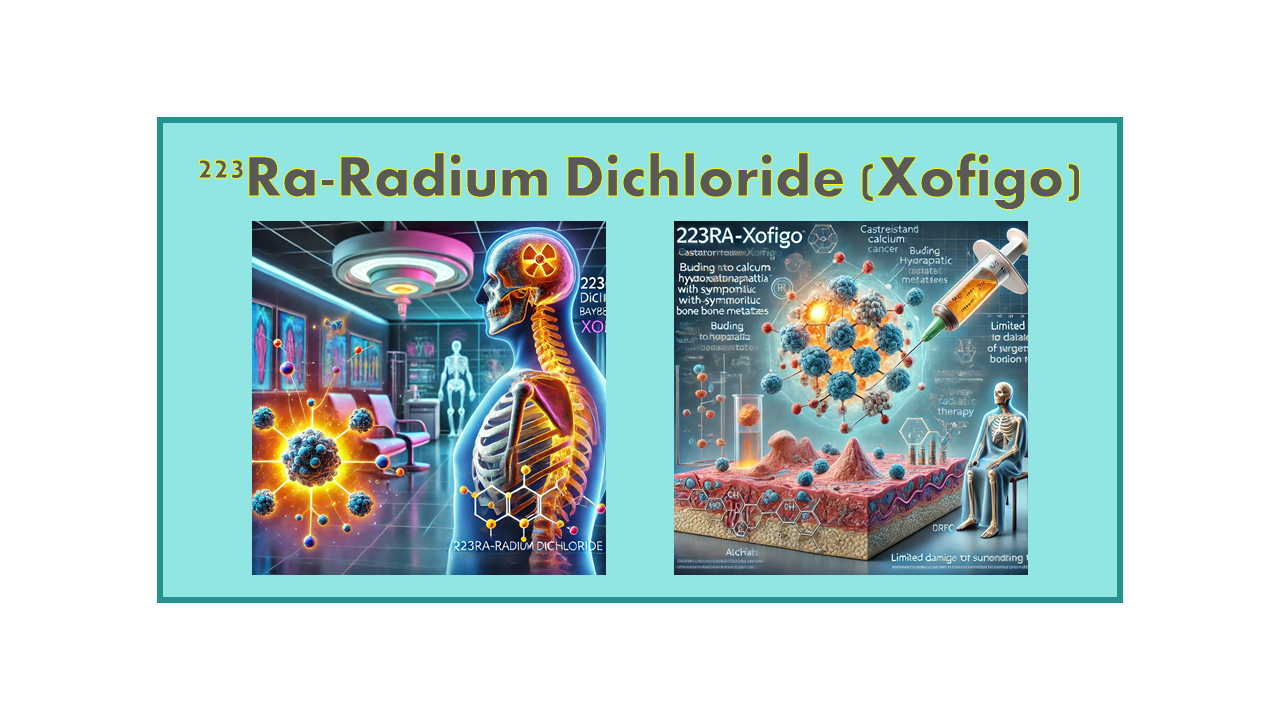
223Ra-Radium Dichloride (Xofigo)
January 3, 2025
Description
223Ra-Radium Dichloride (Xofigo), also known as Radium-223 dichloride, BAY88-8223, or Xofigo® (formerly 223Ra-Alpharadin), is a radioactive salt developed by Algeta ASA. It targets cancers that commonly metastasize to the bone. Unlike earlier radiotherapeutics, which were limited to pain palliation, 223Ra has demonstrated a significant improvement in overall survival (OS) in phase III trials, establishing its role as a therapeutic agent.
In 2009, Bayer Healthcare Pharmaceuticals Inc. acquired Xofigo from Algeta for approximately $800 million (€615 million) and a significant royalty agreement. Bayer subsequently gained global health authority approvals, commercialized Xofigo, and acquired Algeta outright in 2014.
- Regulatory Milestones:
- US FDA Approval: May 15, 2013.
- European Medicines Agency (EMA) Approval: November 2013.
- Japan Approval: March 2016.
Clinical Applications
Xofigo is approved in over 40 countries, including the US, EU, and Japan, for:
- Castration-Resistant Prostate Cancer (CRPC):
- Specifically in patients with symptomatic bone metastases and no known visceral metastatic disease.
Mechanism of Action:
- Radium-223 mimics calcium and targets bone mineral hydroxyapatite at areas of increased bone turnover, such as metastases.
- The high linear energy transfer of alpha particles induces double-strand DNA breaks in tumor cells, providing a localized anti-tumor effect.
- The short range of alpha particles (<100 µm) minimizes damage to surrounding healthy tissue.
Clinical Trial Evidence:
- The ALSYMPCA trial (921 patients, 100 centers, 19 countries) demonstrated:
- A 30.5% reduction in the risk of death compared to placebo.
- Median OS of 14.9 months with 223Ra versus 11.3 months with placebo.
Dosage:
- Administered as 50 kBq (1.35 µCi) per kg of body weight every 4 weeks for six injections.
- Each vial contains 6 mL of 1 MBq/mL solution (total 0.16 mCi or 6 MBq per vial).
Production and Costs
- A dedicated manufacturing facility in Indianapolis, operated by Cardinal Health, was completed in 2017.
- Cost:
- US: ~$69,000 for six injections.
- Europe: €35,000–€40,000.
Market Performance and Sales
- Initial market potential was estimated at €800 million ($1 billion) annually by 2017.
- Actual sales have not exceeded $500 million annually, primarily due to high costs and limited patient benefit.
- 2021 Sales: €130 million for the first half of the year.
Competition
223Ra-Radium Dichloride (Xofigo) is unique as the only bone-targeted agent with demonstrated OS benefits, albeit modest (3 months). However, new CRPC treatments (e.g., Provenge, Zytiga, Xtandi) present competition. Other bone-targeted radiopharmaceuticals, such as:
- 153Sm-Lexidronam (Quadramet), 89Sr-Sodium Chloride (Metastron), and 32P-Sodium Phosphate lack OS benefits but share palliative roles.
Emerging therapies like 188Re-HEDP and 177Lu-PSMA/225Ac-PSMA analogues are anticipated to challenge Xofigo’s market share, offering potential improvements in survival.
Challenges and Opportunities
- Side Effects: EMA warnings (2017) noted increased post-treatment fractures, even in monotherapy settings. These findings contributed to stagnating sales.
- Market Dynamics:
- Alpha-emitter products, such as 223Ra, have spurred broader pharmaceutical interest in nuclear medicine.
- The high price ($69,000 per treatment course) aligns with similar therapies but limits accessibility.
- Reimbursement policies and funding decisions are critical to sustaining growth.
Future Prospects:
- Continued development of Bayer’s radiotherapeutic pipeline, including 227Th-labeled molecules, depends on market performance and clinical outcomes.
- Advancements in 177Lu-PSMA and 225Ac-PSMA analogues could overshadow Xofigo’s therapeutic role.
Conclusion
223Ra-Radium Dichloride (Xofigo) represents a breakthrough in nuclear medicine with its ability to extend survival in CRPC patients with bone metastases. However, challenges in pricing, side effects, and competition may limit its long-term market dominance. As new therapies emerge, Xofigo’s future will depend on its ability to adapt to an evolving therapeutic landscape while maintaining its role in specialized cancer care.